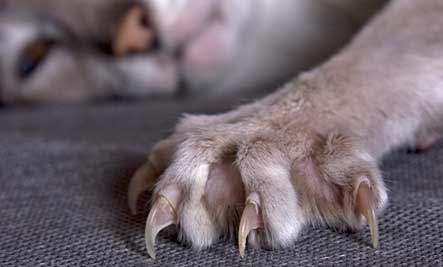Cats obviously have a compelling need to stretch and sharpen their claws. Cats scratch for multiple reasons, which include territorial marking, stretching tendons, expediting the shedding of their claws’ outer sheath and because it just feels sooo good. Unfortunately, sharp kitty claws do not upgrade your sofa or Persian rug, but rather quite the opposite.
Declawing kitty was once deemed a reasonable solution, but over time it has become clear that declawing is inhumane and can lead to a plethora of physical, social and emotional problems – and the last thing you need is a weekly bill from a cat psychiatrist! (For a great overview of all the reasons not to declaw kitty, visit Cats Scratching.)
So your kitty has a full rack of razor sharp claws and you have the frayed furniture to prove it. Now what? Think redirect. To redirect a cat’s naughty scratching patterns, we found that the following methods are useful:
1. Add tea tree oil or lemon essential oil to water in a spray bottle and heavily mist the furniture and/or rugs that you want kitty to ignore. You can also apply tea tree or lemon oil directly to darker areas of carpeting.
Do a test spot to make sure your carpet will withstand the tea tree or lemon essential oil application. (FYI: Do not be turned-off by the term “oil.” Essential oils are actually not very oily at all). The strong scent of lemon or tea tree is distasteful to cats, but it will diminish over time and you will need to reapply weekly or biweekly.
2. Now that your carpets and furniture are off limits, you must offer an alternative for itchy claws especially for indoor-only cats. Scratching posts are the obvious solution, but not always the solution. We have found three items particularly enticing for kitty claws: jute door mats, carpeted cat furniture and a good old-fashioned log. Scratching posts made out of sisal also tend to receive feline approval. Whichever item you choose, make sure the item is secure (if it wobbles or topples your cat will likely never look at it again). Also, ensure your cat will be able to stretch about 1 metre when they do their kitty yoga and sharpening.
If you have more than one cat, you may have to offer more than one option as cats, like humans, have individual preferences. Do consider rubbing catnip on as an extra enticer. Do place the new scratching item in an area your kitty favours and that is not in a far-off corner of your house. But remember, part of the desire to scratch is actually a desire to mark their territory (cat paws have scent glands) and they will want to do it in high traffic areas.
3. Next to try would be lightweight vinyl caps that come in an array of sassy colours, which can be placed over each of your cats claws. The end result: your kitty will have the look of a day spa pedicure but they will not be able to scratch. Such caps are known to prevent many human toddler tears, as kitty just cannot inflict much damage with claws covered in lipstick pink vinyl caps. Your furniture, carpets, curtains and nerves will also be spared.
Adapted from an article by Chrise Udell





